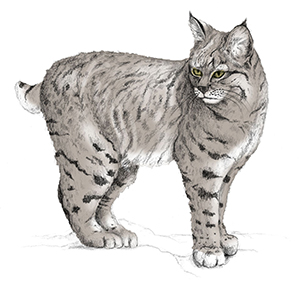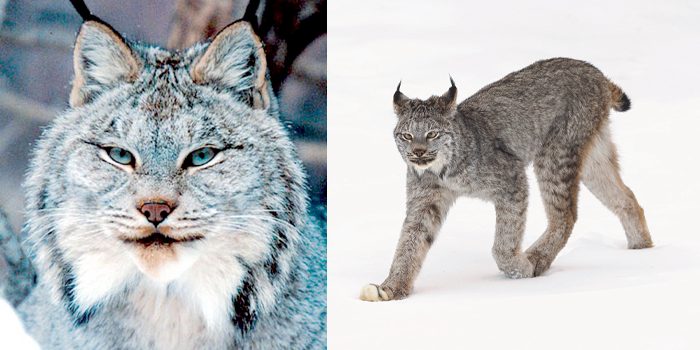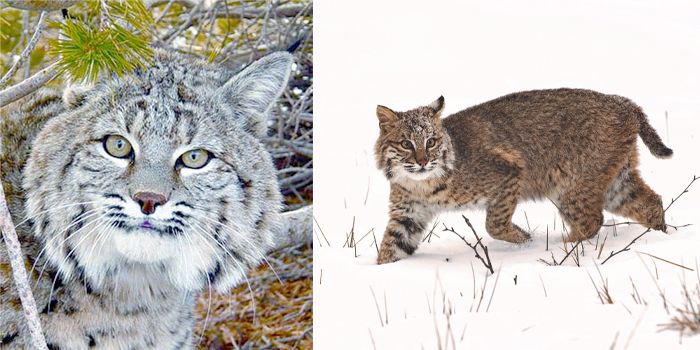Home → Fish & Wildlife → Wildlife → Species Information → Mammals → Bobcat
Bobcat
Lynx rufus
On this page:

Bobcats, which are rare in northwestern sections of Maine due to long winters and deep snow, are common throughout the rest of Maine. They are reclusive animals and are rarely observed in the wild, although they appear to be habituating to urban and suburban settings. Deep snow will force bobcats closer to towns and residences in search of accessible food, causing an increase in bobcat sightings and complaints. Bobcats are an important species in ecosystem structuring, employing top-down regulation on rodent populations.
Habitat
Bobcats use all of the habitats that are found throughout their range in Maine, from agricultural areas to dense woods. Rock cliffs, outcroppings, and ledges are important to bobcats for shelter, raising young, and resting sites. Large brush or log piles and hollow trees or logs are used in wooded areas. Finding bobcats in open fields, meadows and agricultural areas is not uncommon, provided enough brushy or timbered areas for escape cover is nearby. Bobcats occur less frequently in areas of deep winter snow. Historically, it is thought that bobcat populations expanded north since the 1980s, but can often struggle in an attempt to survive severe winters in Maine’s northern areas. Unlike lynx, bobcats have relatively small feet so snow greatly reduces their mobility and ability to catch prey. Home range size of bobcats in Maine varies from about 36 square miles for adult males and about 18 square miles for adult females.
Diet
Bobcats are opportunistic and will prey upon a wide variety of animals. Food sources include mice, voles, snowshoe hare, grouse, woodchucks, beaver, deer (full grown and fawns), and turkeys. They also feed upon insects, reptiles, small birds, and carrion. Bobcats hunt primarily by sight and sound, which means they spend much of their time sitting or crouching, watching, and listening. Once they've located prey, they stalk until they are close enough to make a quick dash, then attack. A bobcat will often cover, or cache, the remains of a large kill with snow, grass, or leaves, revisiting the carcass until most of it is consumed. Once bobcats have located prey, they stalk within range of a quick dash and then pounce. In undisturbed areas, bobcats hunt at dawn or dusk if prey is available, but they can be active any time of day. These cats typically limit their activity in areas occupied by humans to evening hours. In dim light, bobcats can see up to six times better than humans. People rarely see bobcats because of the animal's elusive nature and caution around humans.
Distinctive Characteristics
Adult male bobcats weigh 20 to 30 pounds and average three feet in length. Females are considerably smaller. Bobcats can be various shades of buff and brown, with dark brown or black stripes and spots on some parts of the body. The tip of the tail is black on top and white underneath. These cats have short ear tufts; the ruffs of hair on the side of the head give the appearance of sideburns.
 The print is easily distinguished. It is generally twice the size of a domestic cat's print and loosely resembles that of a coyote or dog but is more rounded and lacks visible toe nails. Members of the dog family leave claw marks; felines do not. There are four toes. At greater speeds the toes of the front foot spread more easily than those of the hind foot, which has a smaller heal pad. Fine, muddy silt leaves the clearest tracks. Although similar in appearance to other cat tracks, bobcat tracks (at about two inches in diameter) are considerably smaller than those of cougar or lynx.
The print is easily distinguished. It is generally twice the size of a domestic cat's print and loosely resembles that of a coyote or dog but is more rounded and lacks visible toe nails. Members of the dog family leave claw marks; felines do not. There are four toes. At greater speeds the toes of the front foot spread more easily than those of the hind foot, which has a smaller heal pad. Fine, muddy silt leaves the clearest tracks. Although similar in appearance to other cat tracks, bobcat tracks (at about two inches in diameter) are considerably smaller than those of cougar or lynx.
Lynx and bobcats are not easy to distinguish.
The tail is the best point of comparison. The tip of a bobcat’s tail is black on top and white beneath; a lynx’s tail is completely black tipped. The feet of a bobcat are noticeably smaller than those of a lynx. In addition, bobcats have shorter ear tufts and a less uniform coat color than a lynx.
Lynx |
Bobcat |
|
|---|---|---|
| Ear Tufts | Generally greater than 1" | Generally less than 1" |
| Facial Ruffs | Larger facial ruffs with black banding at outer edges | Smaller facial ruffs with less distinct banding on outer edge |
| Pelt Color | More uniform coat color. Generally grey pelt including the back of the hind legs. Belly fur greyish white with some black spots. | Reddish brown pelt with distinctive dark brown fur along the back of the hind legs. Belly fur white with distinct black spots. |
| Tail Color | Generally matches body color except the entire tip (about the last 1") is black | Usually has dark bars and the tip of the tail is black on upper side but is white on underside |
| Feet | Large and snowshoe-like feet and hind legs are longer than the front, giving a "stooped" appearance | Smaller feet (proportional to body) and hind legs are not as long as lynx |
| Track Size | In dirt: up to 3 3/8" wide x 3 3/4" long | In dirt: up to 2 5/8" wide x 2 1/2" long |
| In snow: up to 5 1/2" wide x 5 1/2" long | In snow: up to 2 1/2" wide x 2 1/2" long | |
| Stride: 11-18" | Stride: 6-14" |
Nocturnal/Diurnal
Bobcats are often nocturnal and are active hunters during dawn and dusk, likely because their prey may be active during these times and the bobcats have more rods and cones in their eyes, allowing for better vision in the dark. Additionally, the bobcat’s eye (along with most felines) have an elliptical eye shape with larger corneas allowing more light to enter the eye so prey or predators are more prominent at night.
Seasonal Changes
Physical characteristics of bobcat change slightly to allow for better camouflage in its habitat, reddish-brown in the summer and tawny-gray in winter months. Mating occurs between February and March, but bobcat seasonal home ranges and movement increase during spring and summer months when travel is easier.
Reproduction & Family Structure
Bobcats are solitary animals. Males and females only associate for the brief time required for courtship and mating, usually in late February to late March. A litter of one to five kittens is usually born in May on a day-bed located in thick vegetation to deter predators. Young bobcats leave the family group as early as eight months, but often stay with their mother until their first birthday. Bobcats can breed with other felines such as Canada lynx.
Survival & Threats
Bobcats have been known to live up to 12 years in the wild, but the average life expectancy is probably closer to three to four years. Few predators other than fisher and humans are able to kill an adult bobcat. Adult bobcats may receive fatal or debilitating injuries from prey animals. Eagles, great horned owls, coyotes, foxes, bears, and adult male bobcats are known to kill young bobcats.
Management & Conservation
Historically, it is thought that bobcat populations expanded north since the 1980s but can often struggle in an attempt to survive severe winters in Maine’s northern areas. While bobcats are considered a stable species and are currently classified as Least Concern, threats to the population include deforestation and loss of habitat, vehicle collisions, and exposure to rat poison.
MDIFW regulates and manages the hunting and trapping of bobcats. All bobcats harvested must be registered with the Department, along with submission of a tooth and tissue samples to determine age and sex of the animals. Biologists monitor the harvest data to ensure that hunting and trapping levels are sustainable.
Living with Wildlife
How to Prevent or Resolve Conflicts with Bobcat
Although bobcat will kill small livestock (e.g., chickens), it is rare for bobcats to kill domestic animals. Should there be a pattern, homeowners can use some management strategies to minimize conflicts.
Learn more about how to prevent or resolve conflicts with bobcats